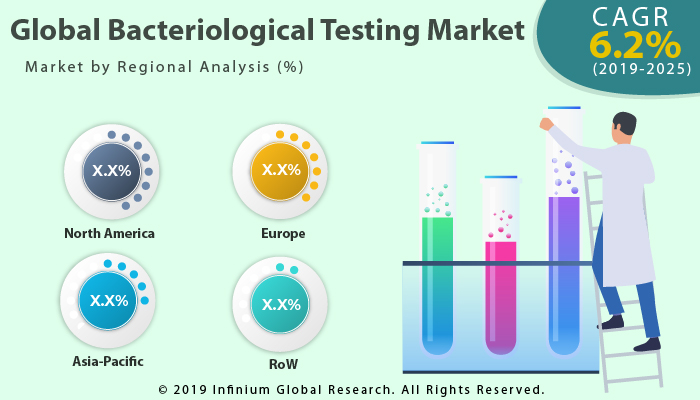Bacteriological Testing Market (Bacteria - Coliform, Salmonella, Campylobacter, Listeria, Legionella, and Other Bacteria; Technology - Traditional Technology, and Rapid Technology; End-user - Food & Beverage, Water, Pharmaceuticals, Cosmetics, and Other End Users; Component - Instruments, Test Kits, and Reagents & Consumables): Global Industry Analysis, Trends, Size, Share and Forecasts to 2025
A recent report published by Infinium Global Research on
bacteriological testing market provides an in-depth analysis of segments and sub-segments
in the global as well as regional bacteriological testing market. The study
also highlights the impact of drivers, restraints, and macro indicators on the
global and regional bacteriological testing market over the short term as well
as long term. The report is a comprehensive presentation of trends, forecast
and dollar values of the global bacteriological testing market. According to the
report, the global bacteriological testing market is projected to grow at a
CAGR of 6.2% over the forecast period of 2019-2025.
Market Insight
The growing incidence of the foodborne problem around the world is
helping to grow the demand for the bacteriological testing market. The unsafe
food contains several harmful bacteria, viruses, chemical substance, parasites,
which are responsible for more than 200 foodborne problems such as diarrhea,
cancers. As per the World Health Organization, around 600 million people come
under the trap of foodborne problem every year, and 4,20,000 people die every
year due to the food-related health problem. Further, children are the
vulnerable segment of the food-related problems. As per the World Health
Organization's estimation, children below 5 years constitute around 40% of the
foodborne patient pool, and 1,25,000 children die every year. Diarrhoeal
diseases are one of the major problems of the foodborne problem and are
responsible for the 230000 death every year.
The growing incidence of the foodborne problems around the world
is helping to grow the demand for the bacteriological testing market. Further,
the growing demand for safe and healthy food products from the millennial
consumers around the world is motivating the food manufacturers to provide the
safe food to the consumers is helping to grow the bacteriological testing market.
Moreover, the adaptation of the standard bacteriological testing procedure to
provide safe food to the consumers helps to improve the brand value of the
concerned companies and provide an opportunity to charge a premium price for
that. This factor is also facilitating the growth of the bacteriological
testing market. However, the lack of government commitment and laissez-faire the attitude of the regulatory and enforcement authorities are restricting the
growth of the bacteriological testing market in the potential region. Moreover,
the growing awareness among the consumers about the consumption of safe food
products in the developing countries is expected to boost the demand for the
bacteriological testing market in the said regions.
Geographically, the bacteriological testing market is divided into
four regions namely, North America, Europe, the Asia-Pacific, and RoW. North
America is the largest player of the bacteriological testing market, owing to
the presence of strong food safety rules and regulations by the federal
government. Additionally, the presence of a large number of the food processing
industries, and organized food retail chains are helping to grow the demand of
the bacteriological testing market. The Asia-Pacific bacteriological testing
market is expected to grow at the highest CAGR during the forecast period,
owing to the growing government focus to provide safe and healthy food to the
masses.

Segment Covered
The report on the global bacteriological testing market covers
segments such as bacteria, technology, end-user, and component. On the basis of
bacteria, the sub-markets include coliform, salmonella, campylobacter,
listeria, legionella, and other bacteria. On the basis of technology, the
sub-markets include traditional technology, and rapid technology. On the basis
of end-user, the sub-markets include food & beverage, water,
pharmaceuticals, cosmetics, and other end users. On the basis of component, the
sub-markets include instruments, test kits, and reagents & consumables.
Companies Profiled:
The report provides profiles of the companies in the market such
as Romer Labs Inc., Bio-Rad Laboratories, Agilent Technologies, Merck &
Co., Thermo Fisher Scientific, The 3M Company, ALS Limited, TUV SUD, Bureau
Veritas S. A., and Intertek Group plc.
Report Highlights:
The report provides deep insights into the demand forecasts, market trends, and micro and macro indicators. In addition, this report provides insights into the factors that are driving and restraining the growth in this market. Moreover, The IGR-Growth Matrix analysis given in the report brings an insight into the investment areas that existing or new market players can consider. The report provides insights into the market using analytical tools such as Porter's five forces analysis and DRO analysis of bacteriological testing market. Moreover, the study highlights current market trends and provides forecast from 2019-2025. We also have highlighted future trends in the market that will affect the demand during the forecast period. Moreover, the competitive analysis given in each regional market brings an insight into the market share of the leading players.
